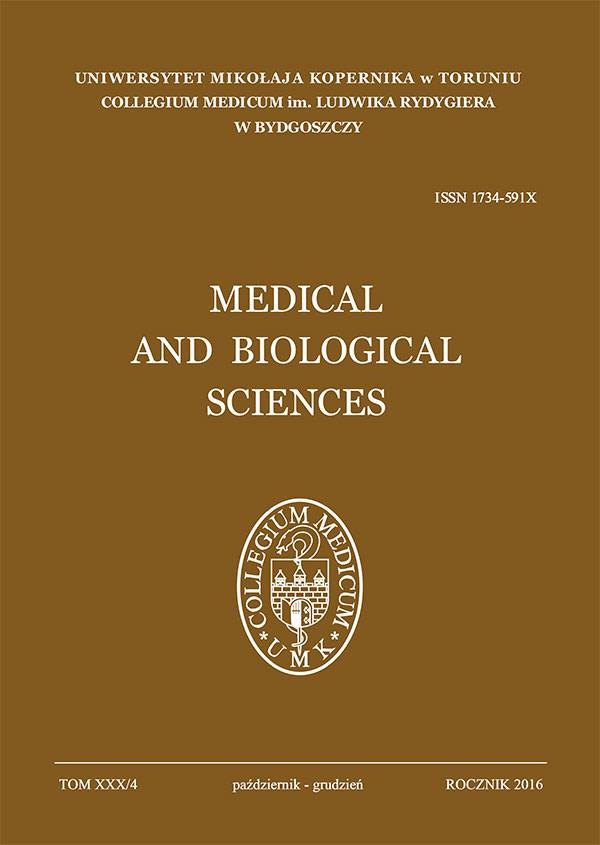The costs of endovascular in-hospital treatment of critical limb ischemia in patients who finally inderwent leg amputation. A one-center experience
DOI:
https://doi.org/10.12775/MBS.2016.029Keywords
assessment, communication, brain injury, disorders of consciousness, assistive technologyAbstract
Background. Currently, the average amputation free survival in patients with critical limb ischemia (CLI) amounts to 76% after one year of follow-up. Such poor prognosis raises the question: is revascularization in patients with CLI cost-effective? The aim of this study was to conduct a cost analysis of vascular care in patients with CLI.
The aim of this study was to conduct a cost analysis of vascular care in patients with CLI.
Patients and methods. A retrospective cost analysis of in-hospital endovascular treatment in 37 patients with CLI who underwent secondary leg amputation between January 2012 and June 2015.
Results. The average length of time between the first endovascular procedure due to CLI and leg amputation amounted to 214 days (range 8-1088 days). The total cost of hospitalizations before leg amputation amounted to 687 603.13 PLN, which is, on average, 18 583.87 PLN per patient, and 86.84 PLN per person per day for living with the preserved lower limb. The total costs associated with the patients who had undergone leg amputation amounted to 404 883.24 PLN, which is an average of 10 942.79 PLN per patient. Previous endovascular procedures accounted for 58.9% of this sum and 37.1% to total management costs for the patients.
Conclusions. The cost per day of endovascular treatment that makes it possible to live with two lower limbs did not exceed the established cost-effectiveness threshold. Lower limb amputation increases the costs of in-hospital patient care by 59%, represents financial wastage for the hospital, and incurs other costs not easily measured.
References
Joret MO, Dean A, Cao C, Stewart J, Bhamidipaty V. The financial burden of surgical and endovascular treatment of diabetic foot wounds. J Vasc Surg. 2016;64(3):648-55. doi: 10.1016/j.jvs.2016.03.421.
Conte MS, Farber A. Revascularization for chronic limb-threatening ischaemia. Br J Surg. 2015;102(9):1007-9. doi: 10.1002/bjs.9848.
Pennywell DJ, Tan TW, Zhang WW. Optimal management of infrainguinal arterial occlusive disease. Vasc Health Risk Manag. 2014;10:599-608. doi: 10.2147/VHRM.S50779.
Norgren L, Hiatt WR, Dormandy JA, Nehler MR, Harris KA, Fowkes FG; TASC II Working Group, Bell K, Caporusso J, Durand-Zaleski I, Komori K, Lammer J, Liapis C, Novo S, Razavi M, Robbs J, Schaper N, Shigematsu H, Sapoval M, White C, White J, Clement D, Creager M, Jaff M, Mohler E 3rd, Rutherford RB, Sheehan P, Sillesen H, Rosenfield K. Inter-Society Consensus for the Management of Peripheral Arterial Disease (TASC II). Eur J Vasc Endovasc Surg. 2007;33 Suppl 1:S1-75.
Jaff MR, White CJ, Hiatt WR, Fowkes GR, Dormandy J, Razavi M, Reekers J, Norgren L. An update on methods for revascularization and expansion of the TASC lesion classification to include below-the-knee arteries: a supplement to the Inter-Society Consensus for the Management of Peripheral Arterial Disease (TASC II): The TASC Steering Committee. Ann Vasc Dis. 2015;8(4):343-57. doi: 10.3400/avd.tasc.15-01000.
Olech A, Hamera A, Suppan K, Banaś W, Wnęk L, Budzyński J. Characteristics of patients who underwent lower limb amputation due to critical limb ischemia - one center exprerience. Med Biol Sci. 2016;30(3):5-14.
Hamera A, Olech A, Koza K, Grzelążka P, Trofimiuk A, Banaś W, Suppan K, Budzyński J. Risk factors for major leg amputation in patients treated endovascularly due to critical limb ischaemia. Acta Angiol. 2015;21(4):122-8.
Vierthaler L, Callas PW, Goodney PP, Schanzer A, Patel VI, Cronenwett J, Bertges DJ, Vascular Study Group of New England. Determinants of survival and major amputation after peripheral endovascular intervention for critical limb ischemia. J Vasc Surg. 2015; 62:655-64. doi: 10.1016/j.jvs.2015.04.391.
Krzanowski M, Drelicharz L, Belowski A, Partyka L, Sumek-Brandys B, Ramakrishnan PK, Niżankowski R. Costs of real-life endovascular treatment of critical limb ischemia: Report from Poland-A European Union country with a low-budget health care system. Ann Vasc Surg. 2016;31:111-23. doi: 10.1016/j.avsg.2015.08.016.
Health Quality Ontario. Stenting for peripheral artery disease of the lower extremities: an evidence-based analysis. Ont Health Technol Assess Ser. 2010;10(18):1-88.
Bradbury AW, Adam DJ, Bell J, Forbes JF, Fowkes FG, Gillespie I, Raab G, Ruckley CV. Multicentre randomised controlled trial of the clinical and cost-effectiveness of a bypass-surgery-first versus a balloon-angioplasty-first revascularisation strategy for severe limb ischaemia due to infrainguinal disease. The Bypass versus Angioplasty in Severe Ischaemia of the Leg (BASIL) trial. Health Technol Assess. 2010;14(14):1-210, iii-iv. doi: 10.3310/hta14140.
Dosluoglu HH, Lall P, Harris LM, Dryjski ML. Long-term limb salvage and survival after endovascular and open revascularization for critical limb ischemia after adoption of endovascular-first approach by vascular surgeons. J Vasc Surg. 2012;56(2):361-71. doi: 10.1016/j.jvs.2012.01.054.
Brosi P, Dick F, Do DD, Schmidli J, Baumgartner I, Diehm N. Revascularization for chronic critical lower limb ischemia in octogenarians is worthwhile. J Vasc Surg. 2007;46(6):1198-207.
Nguyen BN, Conrad MF, Guest JM, Hackney L, Patel VI, Kwolek CJ, Cambria RP. Late outcomes of balloon angioplasty and angioplasty with selective stenting for superficial femoral-popliteal disease are equivalent. J Vasc Surg. 2011;54(4):1051-7.e1. doi: 10.1016/j.jvs.2011.03.283.
van den Houten MM, Lauret GJ, Fakhry F, Fokkenrood HJ, van Asselt AD, Hunink MG, Teijink JA. Cost-effectiveness of supervised exercise therapy compared with endovascular revascularization for intermittent claudication. Br J Surg. 2016. doi: 10.1002/bjs.10247.1.
Kurichi JE, Vogel WB, Kwong PL, Xie D, Bates BE, Stineman MG. Factors associated with total inpatient costs and length of stay during surgical hospitalization among veterans who underwent lower extremity amputation. Am J Phys Med Rehabil. 2013;92(3):203-14. doi: 10.1097/PHM.0b013e31827446eb.
Vemulapalli S, Greiner MA, Jones WS, Patel MR, Hernandez AF, Curtis LH. Peripheral arterial testing before lower extremity amputation among Medicare beneficiaries, 2000 to 2010. Circ Cardiovasc Qual Outcomes. 2014;7(1):142-50. doi: 10.1161/CIRCOUTCOMES.113.000376.
Downloads
Published
How to Cite
Issue
Section
Stats
Number of views and downloads: 446
Number of citations: 0



